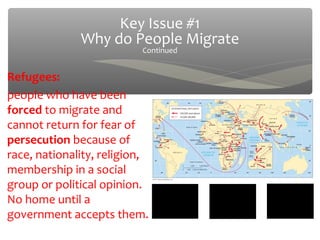
Migration day 2
- 1. Key Issue #1 Why do People Migrate Continued Refugees: people who have been forced to migrate and cannot return for fear of persecution because of race, nationality, religion, membership in a social group or political opinion. No home until a government accepts them.
- 2. Refugees Today ∗ 4/5 of refugee population hosted by developing countries. ∗ The 48 least developed countries host 2.3 million refugees.
- 3. Key Issue #1 Why do People Migrate Continued Distance of Migration ∗Most migrants relocate a short distance and remain within the same country. ∗Long-distance migrants to other countries head for major centers of economic activity.
- 4. Distance of Migration Internal migration = permanent movement within the same country Two types: ∗ Interregional migration = permanent movement from one region to another -Minnesota to Florida ∗ Intraregional migration = permanent movement within a region -Winona to Rochester
- 6. Distance of Migration International migration - permanent movement from one country to another. Two types: ∗ Voluntary migration implies that migrant has chosen to move, largely due to economic factors ∗ Forced migration means that migrant is compelled to move, usually due to cultural factors (persecution, politics)
- 8. Kinds of Voluntary Migration ∗ Step Migration – When a migrant follows a path of a series of stages, or steps toward a final destination. * intervening opportunity – at one of the steps along the path, pull factors encourage the migrant to settle there. ∗ Chain Migration – When a migrant communicates to family and friends at home, encouraging further migration along the same path, along kinship links.
- 10. Characteristics of Migrants ∗ Most long-distance migrants are male. ∗ Most long-distance migrants are adult individuals rather than families with children.
- 11. Immigrant Population, by Age and Sex, for the United States: 2010 Native Population, by Age and Sex, for the United States: 2010
- 12. Characteristics of Migrants to the United States ∗ 40% are young adults between 25-39. 23% of U.S. native population is in this age band. ∗ 5% of immigrants are over age 65. 12% of U.S. native population over 65.
